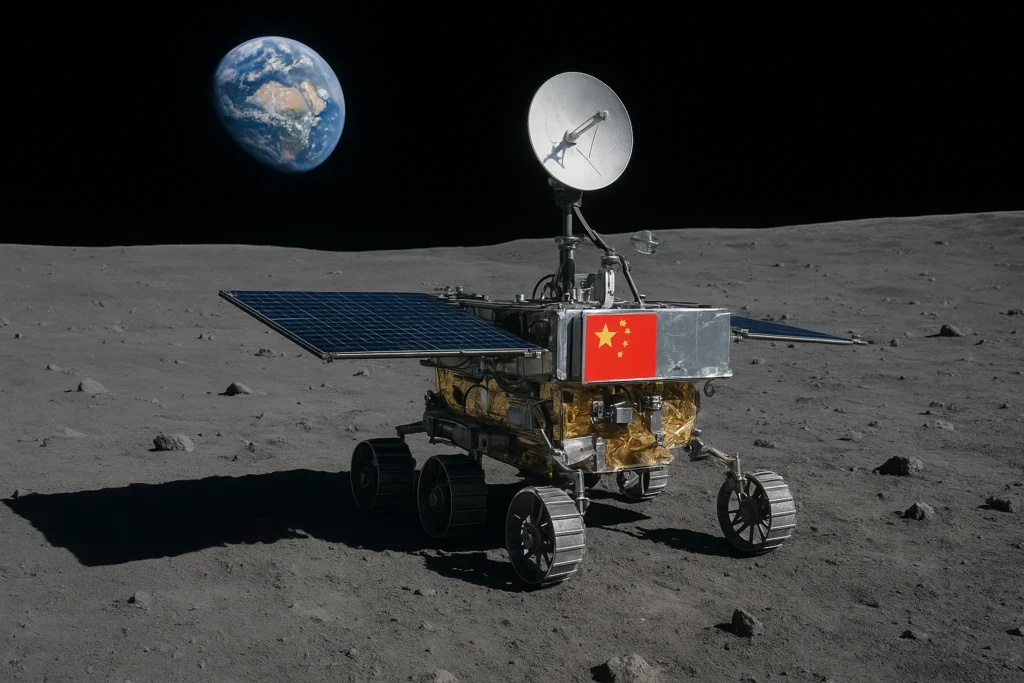Beneath the infinite black canvas of space, a silent sentinel has watched over Earth for over four billion years. We know its face intimately—the familiar patterns of dark seas and bright highlands that have guided explorers, inspired artists, and sparked the curiosity of scientists for all of human history. But this familiar face is a mask. For just as long, a hidden hemisphere has remained perpetually turned away, a vast, silent realm untouched by Earthlight, unseen by human eyes, and shrouded in the deepest mysteries of our solar system’s violent birth. This is the far side of the Moon, the ultimate hidden frontier, a locked vault containing chapters of cosmic history we have never been able to read.
That is, until now. We are living in the opening moments of a new lunar renaissance, a second great age of exploration that is fundamentally more ambitious, more complex, and more scientifically profound than the first. Spearheading this new epoch is a robotic ambassador of breathtaking sophistication: China’s Chang’e-6 mission. This is not merely a trip to the Moon; it is a meticulously choreographed ballet of engineering and artificial intelligence, an orchestra of machines performing in perfect harmony across a quarter-million miles of void. Its goal is audacious: to land on the Moon’s most treacherous and ancient terrain, to navigate a landscape of eternal silence, to drill into the primordial bedrock, and to achieve the ultimate prize—returning the first-ever samples from this hidden world to Earth. This is the story of a geological detective story on a cosmic scale, a quest to answer questions as old as the Earth itself.
Act I: The Roar That Breaks the Silence – A Launch from Wenchang
Every great journey begins with a single, defining moment. For Chang’e-6, it commenced on a humid, pre-dawn morning on Hainan Island, China. At the Wenchang Satellite Launch Center, the air, thick with the salt of the South China Sea, crackled with anticipation. Against the fading tapestry of stars stood a colossal Long March 5 rocket, a titan of modern engineering. Its white fuselage, gleaming under powerful spotlights, contained the hopes of thousands of scientists and the culmination of decades of technological progress.
The final countdown was a whisper that echoed across continents. In mission control, a silent tension gripped the teams of engineers, programmers, and geologists who had dedicated years of their lives to this single moment. Then, ignition. A thunderous, primal roar shattered the tropical stillness as the rocket’s engines erupted in a controlled sun of fire and light. The very ground trembled in response. Slowly, majestically, fighting the immense pull of gravity, the giant began to climb, a spear of ambition tearing through the atmosphere and punching into the ink-black sky. For those who witnessed it, it was more than a launch; it was the turning of a page in human history, a declaration that the greatest secrets of our celestial companion were finally within reach.
Act II: The Lure of the Lost Hemisphere – A Pristine Cosmic Laboratory
We have long called it the “dark side,” a term born of mystery and popular culture. But this is a misnomer. The far side of the Moon is not perpetually dark; it experiences the same two-week-long days and nights as the side we see. Its true name is simply the “far side”—the hemisphere forever hidden from our view by a celestial quirk of physics known as tidal locking.
Billions of years ago, the Earth’s gravitational pull acted as a brake on the Moon’s rotation, slowing it until its spin perfectly matched its orbit around our planet. The result is a perpetual dance where the Moon presents only one face to Earth, its partner in a cosmic waltz. The other side remained an enigma, a blank space on our map of the solar system until the space age finally gave us the eyes to see it.
This simple astronomical fact is what makes the far side scientifically priceless. Our planet is incredibly loud. We constantly flood space with a cacophony of radio noise from our cell phone networks, television broadcasts, radar systems, and satellites. The near side of the Moon is perpetually bathed in this electronic static. The far side, however, is the quietest place in the inner solar system. It is perfectly shielded from our racket, making it a pristine, silent laboratory, an astronomer’s ultimate dream for a future telescope that could listen to the faint echoes of the universe’s birth.
But the silence is only the beginning of its allure. Shielded from Earth, the far side has a completely different geological biography. It is more rugged, brutally scarred by craters, and strikingly lacks the large, dark, volcanic plains—the maria, or “seas”—that form the face of the “Man in the Moon.” This stark difference is a massive clue to the Moon’s violent formation and its internal evolution. Exploring the far side is like an historian discovering a second, missing volume of a two-book set about the history of our solar system—a volume that promises to rewrite everything we thought we knew.
Act III: The Orchestra of Machines – Meet the Cast of Chang’e-6
The name “Chang’e” is drawn from ancient Chinese mythology, a tale of a moon goddess who ascended to a lunar palace. The missions bearing her name are a series of increasingly complex robotic explorers. Chang’e-6 is not a single spacecraft; it is a full orchestra of specialized machines, a symphony of engineering where each instrument must perform its solo perfectly for the entire piece to succeed.
1. The Service Orbiter: The Mothership and Command Center
This is the unwavering heart and brain of the mission. It will remain in a stable orbit around the Moon for the entire multi-week operation, acting as a command station, power generator, and communications hub. Its most critical job is to wait, patiently circling the grey world below, until it is time to receive the precious cargo and begin the long, precise journey back to Earth.
2. The Lander: The Sturdy Workhorse
This robust, four-legged platform is engineered to survive one of the most nerve-wracking maneuvers in spaceflight: a fully autonomous “controlled descent” onto the most challenging lunar terrain imaginable. Using a suite of sophisticated cameras, lidar, and advanced hazard-avoidance systems, its computer brain must make millions of calculations in real-time to find a safe, flat spot to touch down amidst a treacherous field of craters and boulders. It is the delivery system for the mission’s precious payload.
3. The Robotic Arm: The Geologist’s Hands and Eyes
Chang’e-6’s primary explorer is a sophisticated robotic arm attached to the lander itself. This arm is a marvel of precision engineering, designed to operate flawlessly in the vacuum of space and withstand temperature swings of hundreds of degrees. It is equipped with a scoop for fine soil and a powerful drill for coring into rock. It is the mission’s field geologist, its sensitive hands and analytical eyes, tasked with the meticulous work of selecting, examining, collecting, and sealing the best possible samples.
4. The Ascent Vehicle: The Great Escape Artist
This is perhaps the most audacious piece of technology on the mission: a small, powerful, multi-stage rocket sitting on top of the lander. Once the samples are sealed in their protective capsule, this vehicle will perform a feat never before attempted from the far side: it will launch from the lunar surface. Igniting its engines in the airless void, it will blast off from the Moon’s gravity, aiming for a precise rendezvous with the mothership orbiting above.
5. The Queqiao-2 Satellite: The Unsung Hero and Celestial Switchboard
This component is the true enabler of the entire mission. Because the far side of the Moon never faces Earth, direct communication is impossible. To solve this, China first launched the Queqiao-2 (“Magpie Bridge-2”) satellite, a specialized communications relay. Now parked in a special orbit, it acts as a celestial “switchboard,” bouncing commands from Earth to the lander and sending the lander’s priceless data and images back home. Without this silent sentinel, the entire mission would be lost in silence.
Act IV: Destination South Pole-Aitken Basin – The Moon’s Oldest Scar
The Chang’e-6 mission isn’t landing just anywhere. It is headed for a location of almost unimaginable scale and significance: the South Pole-Aitken (SPA) Basin. This is not merely a crater; it is the single largest, deepest, and oldest recognized impact structure in our entire solar system. To grasp its scale, imagine a hole so vast it could stretch across the entire continental United States—over 1,600 miles (2,500 kilometers) in diameter—and so deep it reaches dozens of miles down into the lunar crust.
The impact that created this basin over 4 billion years ago was a cataclysm of near-incomprehensible violence. It was likely caused by a protoplanet or asteroid the size of a small city moving at hypersonic speed. The energy released exceeded the combined force of every nuclear weapon on Earth. This event did more than leave a scar; it is believed to have punched so deep that it excavated and ejected material from the Moon’s mantle—the deep, inner layer that lies beneath the crust. For planetary scientists, the SPA Basin is the holy grail. By collecting samples here, Chang’e-6 is giving us a free ticket to dig miles beneath the surface without ever lifting a shovel. The rocks it collects could be pristine pieces of the Moon’s ancient interior, time capsules untouched for over four billion years.
Act V: The Delicate Dance – The Art of Cosmic Collection
The core of the mission is a slow, meticulous dance of collection that will unfold over days. Once the lander is safe, its systems will awaken. Cameras will create detailed 3D maps of the surroundings. On Earth, scientists will pore over these images as virtual field geologists, searching for the perfect rocks and soil patches that tell the most compelling story.
Guided by their commands, the robotic arm will unfold. Its mission is two-fold:
- Scooping the Regolith: The arm will collect the fine, gray, abrasive dust that blankets the Moon. This regolith isn’t just dirt; it’s a unique historical record of billions of years of micrometeorite bombardment, containing implanted particles from the solar wind and glassy beads formed in ancient impacts. It is a history book written in dust.
- The Deep Drill: This is the critical task. The arm will maneuver a drill to bore several feet down, extracting long, core samples of layered rock and soil. These cores are invaluable because they preserve the stratigraphy—the order and context of the geological layers. This context is vital for understanding the sequence of events that shaped this landscape.
Each sample will be meticulously documented and sealed in a multiple-layer, airtight container aboard the ascent vehicle. This container is a masterpiece itself, designed to maintain a perfect vacuum seal, ensuring the samples remain as pure as they were on the Moon.
Act VI: The Impossible Launch and the Orbital Rendezvous
After collection, the mission enters its most nail-biting phase. The ascent vehicle, with its priceless cargo, must launch from the lunar surface—a feat never before attempted from the far side. Autonomously, it will ignite, rising like a tiny star in the black sky over the far side. It must navigate itself perfectly into a predetermined orbit.
Meanwhile, high above, the service orbiter has been adjusting its path. It must now become a hunter, locating the tiny ascent vehicle in the vastness of lunar orbit. Then, they must perform a delicate, automated orbital rendezvous and docking. The two spacecraft, moving at thousands of miles per hour, must find each other and dock with millimeter precision, all without human intervention. Once docked, the sample container is transferred to the orbiter, which then fires its engines for the trans-Earth injection, setting course for home.
Act VII: The Fiery Return and the Opening of the Vault
The final act is a triumphant and fiery homecoming. As the orbiter approaches Earth, it releases the sample return capsule. This capsule is a fortress, with a heat shield designed to burn away to withstand the blistering temperatures of atmospheric re-entry. It will streak across the sky like a meteor before parachuting gently down to the grasslands of Inner Mongolia.
Recovery teams will secure the capsule and transport it to a state-of-the-art curation facility—a laboratory cleaner than any hospital. Here, scientists in protective suits will work in sterile, nitrogen-filled gloveboxes to slowly, reverently open the vault. They will be the first humans to lay eyes on rocks that have existed in total isolation since before the first complex life formed on Earth.
Act VIII: The Secrets Within – Rewriting Our Cosmic History
These few pounds of rock and dust are not trophies; they are cryptic history books. Their analysis could revolutionize our understanding of:
- The Moon’s Birth: They could contain chemical clues confirming the Giant Impact Hypothesis—that the Moon formed from debris after a Mars-sized planet, Theia, struck the infant Earth.
- The Solar System’s Violent Youth: Precisely dating these samples will clarify the timeline of the Late Heavy Bombardment, a period when asteroids pummeled the inner planets, potentially delivering the water and organic compounds that made life on Earth possible.
- The Future of Astronomy: Data on the far side’s environment paves the way for a future radio telescope there, which could peer into the “Cosmic Dark Ages” before the first stars lit up, free from all Earthly interference.
Epilogue: A Legacy Beyond Borders
The Chang’e-6 mission is a monumental achievement that transcends national borders. It is a catalyst for a new, global “Moon rush,” demonstrating that ambitious robotic exploration is not just possible but essential. It complements NASA’s Artemis program and inspires international partnerships and private ventures. It proves that the Moon is not a destination of the past, but a stepping stone to the wider solar system and a classroom for understanding our own planet’s place in the cosmos. The silent sentinel has waited 4.5 billion years. Soon, its deepest secrets will finally be heard.



